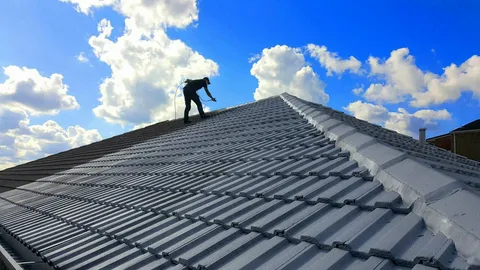Is Tile Roofing Worth the Investment? Pros, Cons, and ROI

When considering a new roof for your home, the choices can feel overwhelming. From traditional asphalt shingles to modern metal options, each material offers unique benefits and drawbacks. But one material stands out for its enduring beauty, remarkable durability, and significant long-term value: tile roofing. Often associated with Mediterranean or Spanish architecture, tile roofs are increasingly popular across diverse home styles, and for good reason.
However, the upfront cost of tile roofing can be a significant consideration. So, is tile roofing truly worth the investment? Let’s delve into the pros, cons, and the potential return on investment (ROI) with insights from a trusted roofing company to help you make an informed decision for your property.
The Enduring Appeal: Pros of Tile Roofing
Tile roofs have graced homes for centuries, proving their resilience and aesthetic prowess. Their advantages extend far beyond mere visual appeal:
-
Exceptional Longevity: This is arguably the biggest selling point of tile roofing. While asphalt shingles typically last 20-30 years, properly installed and maintained tile roofs can endure for 50, 75, or even 100 years. This incredible lifespan significantly reduces the frequency of replacements, offering immense peace of mind over the decades.
-
Superior Durability and Weather Resistance: Tile is inherently robust. Whether made from clay or concrete, it stands up exceptionally well to harsh weather conditions. It's highly resistant to strong winds, heavy rain, hail, and even fire. This makes it an excellent choice for regions prone to extreme weather, providing a strong protective barrier for your home.
-
Energy Efficiency: Tile roofs offer natural insulating properties. The air circulation between the tiles and the roof deck helps regulate indoor temperatures, keeping your home cooler in hot climates and warmer in colder ones. This thermal mass can lead to noticeable reductions in your energy bills and a more comfortable living environment.
-
Aesthetic Versatility and Curb Appeal: Tile roofing offers unparalleled beauty and variety. Available in a vast array of colors, shapes, and profiles – from classic barrel tiles to flat, modern designs – they can perfectly complement almost any architectural style. This enhances your home's curb appeal and can significantly boost its market value.
-
Low Maintenance: While not entirely maintenance-free, tile roofs generally require less upkeep compared to other materials. They are resistant to rot, pests, and fungi. Regular inspections, cleaning of debris, and prompt replacement of any cracked tiles are usually sufficient to maintain their integrity. This contributes to lower long-term costs.
-
Eco-Friendly Option: Many tile materials, particularly clay and concrete, are made from natural, sustainable resources. Their extreme longevity also means fewer materials end up in landfills over time, making them a more environmentally responsible choice for homeowners concerned about sustainability.
The Considerations: Cons of Tile Roofing
Despite its many benefits, tile roofing does come with certain considerations that homeowners should be aware of:
-
Higher Upfront Cost: This is the most significant drawback. Tile roofing has a considerably higher initial material and installation cost compared to asphalt shingles. The specialized skills and time required for tile roof installation contribute to this expense.
-
Significant Weight: Tile is a heavy material. Your existing roof structure may need reinforcement to support the added load, especially if you're replacing a lighter material like asphalt shingles. This structural assessment and potential roof framing upgrades can add to the overall project cost.
-
Fragility Under Impact: While durable against weather, individual tiles can be brittle and prone to cracking or breaking under heavy impact, such as falling tree branches or foot traffic. Repairs, though often simple, require careful handling and the availability of matching replacement tiles.
-
Installation Complexity: Installing a tile roof is a specialized job that requires skilled professionals. Proper alignment, securing, and flashing are crucial for ensuring the roof's longevity and watertight seal. This is not a DIY-friendly project.
Return on Investment (ROI): Is It Worth the Price Tag?
Given the higher initial investment, many homeowners question the return on investment (ROI) of a tile roof. While the direct financial recoup might vary depending on your local real estate market and the specific material, tile roofing offers substantial value in several key areas:
-
Increased Home Value: A tile roof undeniably enhances a home's aesthetic appeal and conveys a sense of quality and luxury. This can significantly increase your home's market value, making it more attractive to potential buyers. Studies often show that roof replacements, especially with premium materials, can offer an ROI in the range of 60-70% of the initial cost at resale. For tile roofs, this can be even higher due to their desirability and longevity.
-
Long-Term Savings: While the upfront cost is higher, the extended lifespan of a tile roof means you avoid multiple replacement cycles that would be necessary with less durable materials. Coupled with potential energy savings from improved insulation, the lifetime cost of a tile roof can be surprisingly competitive, and often lower, than that of frequently replaced, cheaper alternatives.
-
Reduced Insurance Premiums: Some insurance providers offer discounts for homes with highly durable and fire-resistant roofing materials like tile, recognizing the reduced risk of damage. This can lead to ongoing savings on your homeowner's insurance.
-
Quicker Sale Time: Homes with new, high-quality roofs tend to sell faster. Buyers are often willing to pay more for a move-in-ready property with a worry-free roof, avoiding the hassle and expense of a near-future replacement.
Making the Decision
Choosing a roof material is a major decision that impacts your home's protection, aesthetics, and value for decades. Tile roofing, with its impressive longevity, durability, energy efficiency, and stunning visual appeal, presents a compelling case for a long-term investment. While the higher initial cost and weight considerations are valid concerns, the significant ROI through increased home value, long-term savings, and enhanced curb appeal often make it a worthwhile choice for homeowners seeking premium quality and lasting peace of mind. Always consult with experienced roofing professionals to assess your specific needs, get detailed quotes, and ensure proper installation for maximum benefits.
FAQs
Q1: What types of tiles are commonly used for roofing?
A1: The most common types are clay tiles (including terracotta and Spanish/Mission styles) and concrete tiles. Other options include slate tiles (natural stone) and various synthetic or composite tiles that mimic the look of traditional materials.
Q2: How much does a tile roof cost compared to asphalt shingles?
A2: Tile roofs are significantly more expensive upfront than asphalt shingles. While asphalt shingles might cost $4-$8 per square foot installed, tile roofing can range from $7-$40+ per square foot, depending on the material, complexity, and regional labor costs.
Q3: Does a tile roof increase my home's energy efficiency?
A3: Yes, absolutely. The design and material properties of tile roofing create natural airflow and thermal mass that help insulate your home. This can reduce heat transfer, keeping your interior cooler in summer and warmer in winter, leading to lower HVAC usage and energy bills.
Q4: Is a tile roof difficult to maintain?
A4: Tile roofs are generally considered low-maintenance. Routine inspections, cleaning of debris from gutters and the roof surface, and promptly addressing any cracked or missing tiles are typically sufficient. Avoid walking directly on tiles as they can be brittle.
Q5: How long does a tile roof typically last?
A5: With proper installation and maintenance, clay and concrete tile roofs are known for their exceptional longevity, often lasting 50 to 100 years or even longer. This far surpasses the lifespan of most other common roofing materials.








